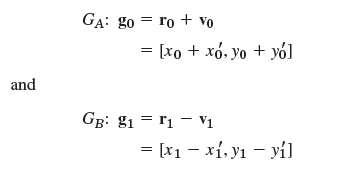In Hermite interpolation we are looking for a polynomial p(x) (of degree 2n + 1 or less)
Question:
(a) Let C be a curve in the xy-plane parametrically represented by r(t) = [x(t), y(t)], 0 ‰¤ t ‰¤ 1. Show that for given initial and terminal points of a curve and given initial and terminal tangents, say,
![А: Го — [x (0), у (0)] 3D [xо. Уol. B: r1 = [x(1), y(1)] = [x1, yı] Vo = [x'(0), y'(0)] — [x6. уб1. V1 = [r](https://dsd5zvtm8ll6.cloudfront.net/si.question.images/images/question_images/1545/1/2/5/1485c18bd1c3aae71545107728742.jpg)
We can find a curve C, namely,

in components,

This is a cubic Hermite interpolation polynomial, and n = 1 because we have two nodes (the endpoints of C). (This has nothing to do with the Hermite polynomials in. The two points

are called guidepoints because the segments AGA and BGB specify the tangents graphically. A, B, GA, GB determine C, and C can be changed quickly by moving the points. A curve consisting of such Hermite interpolation polynomials is called a Bezier curve, after the French engineer P. Bezier of the Renault Automobile Company, who introduced them in the early 1960s in designing car bodies. Bezier curves (and surfaces) are used in computer-aided design (CAD) and computer-aided manufacturing (CAM).
(b) Find and graph the Bezier curve and its guidepoints if A: [0, 0], B: [1, 0], v0 = [1/2, 1/2], v1 = [-1/2, -1/4ˆš3]
Step by Step Answer:






